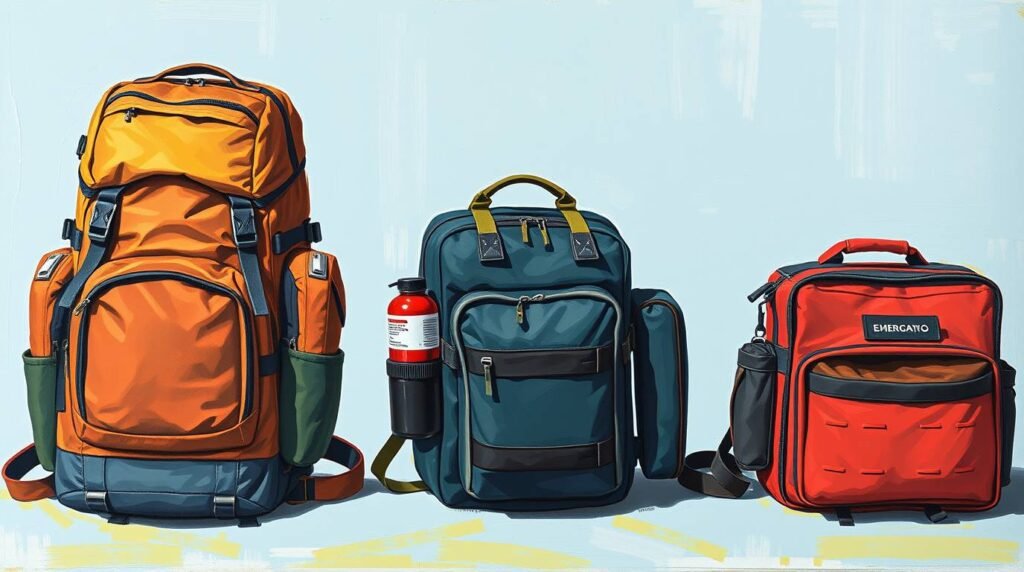
In the world of emergency preparedness, terminology can quickly become confusing. Bug out bag, go bag, 72-hour kit, get home bag, INCH bag—these terms are often used interchangeably, but they actually represent different emergency preparation philosophies designed for specific scenarios. Understanding these distinctions helps ensure your prep bag truly matches your emergency needs rather than following a one-size-fits-all approach.
Bug Out Bag (BOB): The Evacuation Standard
The classic bug out bag serves a specific purpose:
- Primary function: Enable rapid evacuation from your primary residence
- Typical contents: 3 days (72 hours) of supplies for complete self-sufficiency
- Design philosophy: Balance between comprehensive supplies and mobility
- Weight range: Typically 15-25 pounds for adults
- Deployment trigger: Home becomes unsafe or uninhabitable
Your BOB assumes you’re leaving your home environment with everything you need on your back. It’s designed to bridge the gap between evacuation and reaching longer-term shelter or assistance.
Get Home Bag (GHB): The Commuter’s Lifeline
While often confused with bug out bags, get home bags serve a distinctly different purpose:
- Primary function: Enable safe return to your home from work/school/daily activities
- Typical contents: 24-48 hours of minimal supplies focused on mobility
- Design philosophy: Lightweight, concealable, emphasizes navigation and movement
- Weight range: Typically 5-15 pounds to prioritize speed
- Deployment trigger: Disaster strikes while away from home
Your GHB assumes home is your safe haven, not the place you’re fleeing. This fundamental difference shapes everything from what you pack to how you organize it.
72-Hour Kit: The Government Standard
While sometimes used synonymously with bug out bags, 72-hour kits have distinct characteristics:
- Primary function: Provide essential needs during the initial phase of any emergency
- Typical contents: FEMA-recommended supplies for 3 days
- Design philosophy: Often stored in containers besides backpacks (buckets, totes)
- Weight considerations: Less emphasis on portability, more on completeness
- Deployment trigger: Any emergency, not necessarily requiring evacuation
The 72-hour kit concept originated from government emergency management agencies, focusing on the critical three-day period before organized assistance typically arrives.
I’m Never Coming Home (INCH) Bag: The Long-Term Solution
For more serious scenarios, the INCH bag represents a different preparedness tier:
- Primary function: Support extended or permanent relocation
- Typical contents: Supplies for weeks or longer, including sustainment tools
- Design philosophy: Emphasizes skills, tools, and sustainability over consumables
- Weight range: Often 30+ pounds, sometimes distributed across multiple packs
- Deployment trigger: Catastrophic events making home uninhabitable long-term
The INCH bag goes beyond emergency response into emergency living, focusing on rebuilding capacity rather than merely surviving until help arrives.
Which Prep Bag Do You Actually Need?
Most preparedness experts recommend a tiered approach:
- Start with a Get Home Bag if you regularly commute away from home
- Build a Bug Out Bag/72-Hour Kit for your household
- Consider an INCH bag only after mastering the basics
Your specific needs may vary based on:
- Regional disaster profiles (hurricanes, earthquakes, wildfires)
- Urban vs. rural environment
- Family size and composition
- Physical capabilities
- Available transportation options
Creating a Balanced Prep System
The most effective approach combines elements of each bag type:
- Keep a lightweight get home bag in your vehicle or at work
- Maintain a comprehensive bug out bag at home
- Store additional supplies in a non-portable container
- Practice using different bags for their intended purposes
Remember that the best emergency kit isn’t necessarily the one with the most equipment—it’s the one that matches your specific scenarios and capabilities.
For detailed guidance on building a complete 72-hour emergency kit from scratch, check out our comprehensive guide with printable checklists.
Not sure exactly what your specific situation requires? Our interactive bug out bag calculator can help determine which type of prep bag best suits your needs and what it should contain.
The terminology matters less than ensuring your emergency preparations match the actual scenarios you’re most likely to face. Whether you call it a bug out bag, go bag, or 72-hour kit, the right prep bag is the one designed for your specific emergency needs.